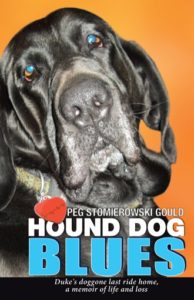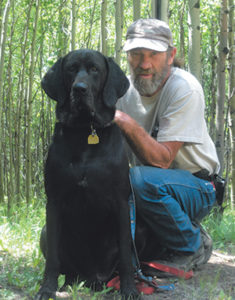These are the words of Peg Gould, Balboa Press author of “Hound Dog Blues”. Peg answered the call to write her book and self-publish with Balboa Press. To learn more about her story visit her website. Download the Balboa Press free publishing guide to receive more information.
Self-Publishing Is An Observational Learning Curve

Self-publishing even a small book is a big proposition. It changes your life, but often in subtle ways. My 2017 book “Hound Dog Blues,” examines an intricate grief — losing pets.
Our bloodhound mix Duke is the central figure. The book recounts the year between his terminal diagnosis and installation of a memorial plaque. It recounts our other dog’s subsequent depression and our premature adoption of a muscled white boxer mix quite afraid of her own shadow.
Why A Book About Duke?
This hulking sloppy dog had a comic presence that turned adults into children. We’d talked about publishing a children’s book. We took pictures of everything else, it seems, but him devouring oblong frozen popsicles we squeezed at the end for him, like working a toothpaste tube. Even back then, we had a pen-name title in mind: “Pete, the popsicle-eating dog.”
But cancer parted us quite abruptly. The two years or more involved in creating “Hound Dog Blues,” from conceptualization to signings, reflected maturing awareness of Darwinian factors facing pets and people alike. The impetus for the book was agreeing to write a chapter in another collaboration, “The Art of Connecting With Nature.” The idea was to help readers incorporate nature into their days; the project proposed a matrix of concerns to vet author contributions, including spiritual and community-mindedness.
As life often has it, the practice of paying closer attention during our daily jaunts to our local dog park brought me to a more intense observation and appreciation of that moment in time. And that progression is here to stay.
 “Hound Dog Blues”
“Hound Dog Blues”
“Hound Dog Blues,” emerged in August 2017. By that Christmas, Mac, one of the two dogs that had made these memorable trips with us, was, like Duke, diagnosed with cancer and had mercifully been put down. The cancer deaths of neighborhood dogs continued to mount.
But since my quest at heart was emotional rather than scientific, I talked with my sisters about our earliest pets. This alone brought intimacy and appreciation for how we took different lessons from our roots. That’s a theme I wish to revisit. I also realized I could have been content observing animal behavior in nature for a living.
Communication is an ongoing challenge in the self-publishing world. As a career journalist. I was used to shouting across the universal desk when a change needed to be made and made right. When the author is not on-site, forms with intricate listings take the place of direct communication — that plus e-mails and voicemails. It can be painstaking at times to nail down a single sentence.
And truly, without marketing, a book’s quiet release to public scrutiny is not unlike a tree falling in the forest, with the requisite inquiry about whether the event makes any real difference without drumrolls. New authors might expect a flurry of activity after a book comes out, but it can take time. Journalists are used to this, and now I understand better why actors may not see their films for years after release. After filming ends, they have moved on.
Sometimes the silence can be a minefield, so it helps to have a life outside of writing. Some people you might expect to pour over your book hardly give it a glance; the occasional stranger is bowled over. A noted author addressed this space, so I know it’s not me alone. Asked on a plane “Is that your book?” he realized the woman a few seats over meant ownership, not authorship. Ha! Egoists beware.
How My Book Came Together

“Hound Dog Blues” wasn’t started as a memoir, not really. The personal connections were sparked chapter to chapter. The title was changed from “Doggone Duke” — too clunky — while the covers, thanks to Duke, came together smoothly. The “impermanence” theme was clarified afterward, at a meeting with monks who were creating, then destroying sand paintings.
This little tale of joy and bereavement still seems to draw readers more interested in dogs than human death, and that is perhaps a marketing glitch. These small realizations surface and swirl around the drain in the author’s brain, shreds of insight, from time to time. But the book is out, and that matters. It’s time to mine other significant veins for gold.
Balboa Press authors who’d like to share a 350-600 word experience related to the self-publishing of their books are invited to do so by the submission form on the Guidelines page. We may not be able to use every story, but we will read and consider them. Balboa Press reserves the right to edit stories for content, grammar, and punctuation accuracy; as well as for space.